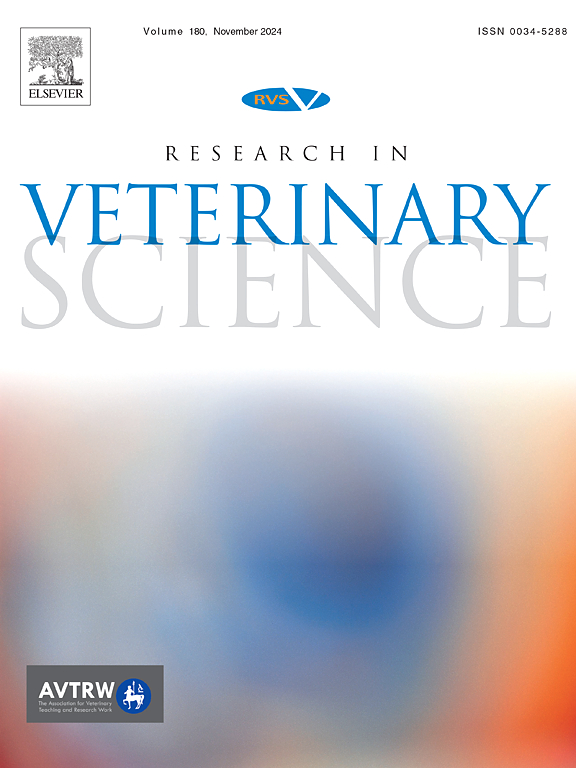受乳腺肿瘤影响的猫科动物的淋巴结状态:超越有无转移的观察
IF 2.2
3区 农林科学
Q1 VETERINARY SCIENCES
引用次数: 0
摘要
本研究的目的是评估肉眼和显微镜下淋巴结特征对总生存时间(OS)的影响,并确定猫乳腺肿瘤淋巴结转移的危险因素。对158只母猫的198个淋巴结进行了回顾性研究。评估诸如转移的存在、大体评估中的淋巴结大小(大体最大直径)、受累淋巴结数量、转移灶数量和转移灶大小(显微镜下最大直径)等参数。此外,我们还分析了囊外延伸的分级、肿瘤植入物、肿瘤大小、组织学类型和组织学分级。使用二元逻辑回归来确定淋巴结直径与肿瘤特征和淋巴结转移之间的关系。测量随访时间,以便预后因素与OS相关。肿瘤分为T2 (2-3 cm)和T3 (>;3cm)出现淋巴结转移的几率分别为2.56倍和2.15倍,而筛状癌出现淋巴结转移的几率是管状乳头状瘤的2.47倍。此外,≥1.5 cm淋巴结发生转移的风险是1.5 cm淋巴结的2.5倍。淋巴结转移、总最大直径(≥1.5 cm)、大转移、≥2个受援淋巴结和III级肿瘤与较短的生存时间相关(P <;0.05)。数据表明,在患有乳腺肿瘤的猫中,对淋巴结和原发肿瘤进行完整的病理检查对于准确预测和指导治疗策略是必要的。本文章由计算机程序翻译,如有差异,请以英文原文为准。
Lymph node status of felines affected by mammary gland neoplasms: a look beyond the presence or absence of metastasis
The purpose of the present study was to assess the influence of gross and microscopic lymph nodes characteristics on overall survival time (OS) and to identify risk factors for lymph nodes metastasis in feline mammary gland tumors. A retrospective study was performed on a total of 198 lymph nodes from 158 female cats. Parameters such as the presence of metastasis, lymph node size in gross evaluation (gross maximum diameter), number of lymph nodes involved, number of metastatic foci, and metastatic focus size (microscopic maximum diameter) were evaluated. Additionally, the grade of extracapsular extension, tumor implant, tumor size, histological type, and histological grade were analyzed. Binary logistic regression was used to determine associations between lymph node diameter and tumor characteristics and lymph node metastasis. Follow-up time was measured so that prognostic factors could be associated with OS. Tumors classified as T2 (2–3 cm) and T3 (> 3 cm) had 2.56 and 2.15 times higher odds of presenting lymph node metastasis, respectively, while cribriform carcinoma had 2.47 times higher odds compared to tubulopapillary tumors. In addition, lymph nodes ≥1.5 cm had a risk of developing metastasis 2.5 times greater than lymph nodes <1.5 cm. Lymph node metastasis, gross maximum diameter (≥ 1.5 cm), macrometastasis, ≥ 2 involved lymph nodes, and grade III tumors were associated with shorter OS time (P < 0.05). Data suggest that in cats with mammary gland neoplasms, a complete pathological examination of lymph nodes and primary tumors is necessary for accurate prognostication and for guiding treatment strategies.
求助全文
通过发布文献求助,成功后即可免费获取论文全文。
去求助
来源期刊

Research in veterinary science
农林科学-兽医学
CiteScore
4.40
自引率
4.20%
发文量
312
审稿时长
75 days
期刊介绍:
Research in Veterinary Science is an International multi-disciplinary journal publishing original articles, reviews and short communications of a high scientific and ethical standard in all aspects of veterinary and biomedical research.
The primary aim of the journal is to inform veterinary and biomedical scientists of significant advances in veterinary and related research through prompt publication and dissemination. Secondly, the journal aims to provide a general multi-disciplinary forum for discussion and debate of news and issues concerning veterinary science. Thirdly, to promote the dissemination of knowledge to a broader range of professions, globally.
High quality papers on all species of animals are considered, particularly those considered to be of high scientific importance and originality, and with interdisciplinary interest. The journal encourages papers providing results that have clear implications for understanding disease pathogenesis and for the development of control measures or treatments, as well as those dealing with a comparative biomedical approach, which represents a substantial improvement to animal and human health.
Studies without a robust scientific hypothesis or that are preliminary, or of weak originality, as well as negative results, are not appropriate for the journal. Furthermore, observational approaches, case studies or field reports lacking an advancement in general knowledge do not fall within the scope of the journal.
 求助内容:
求助内容: 应助结果提醒方式:
应助结果提醒方式:


